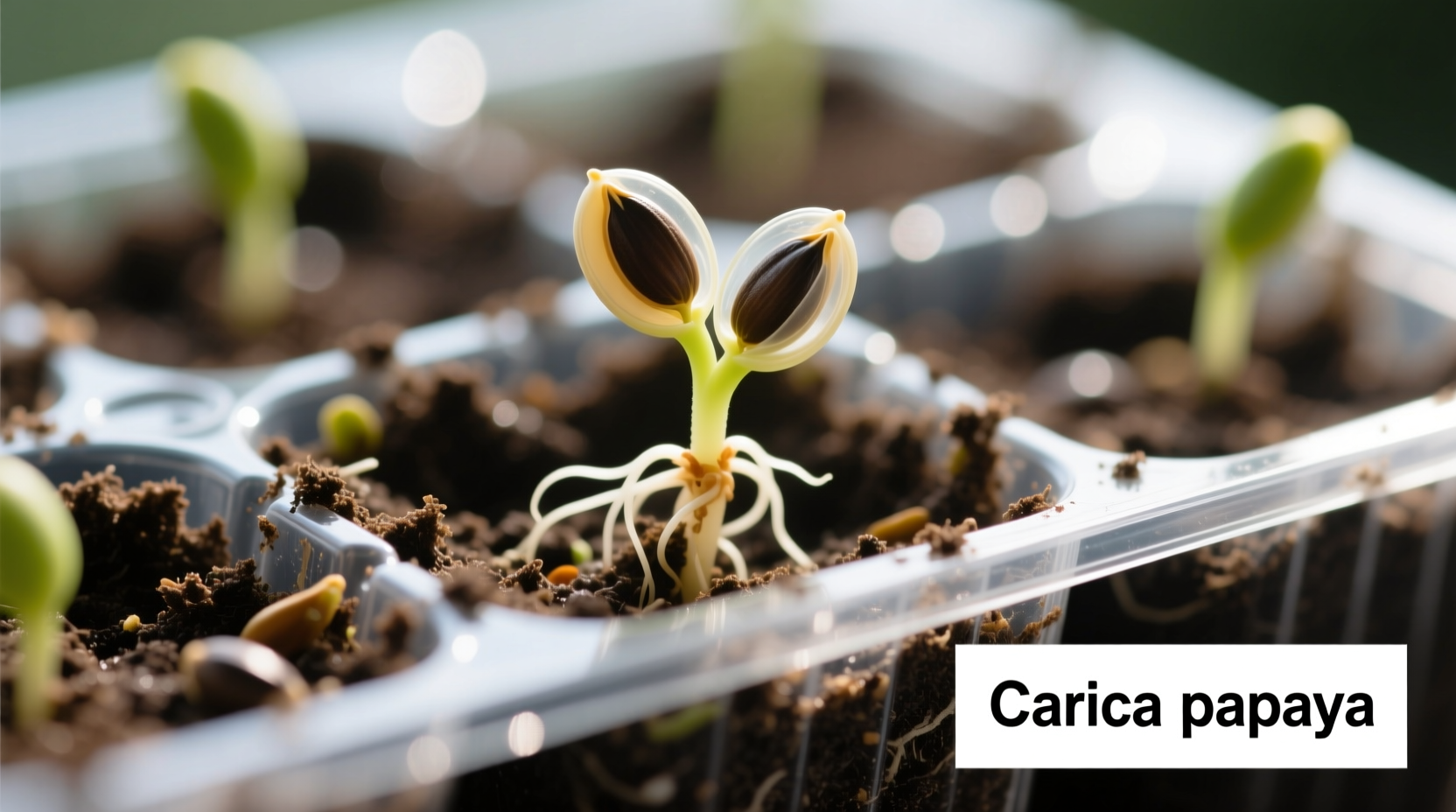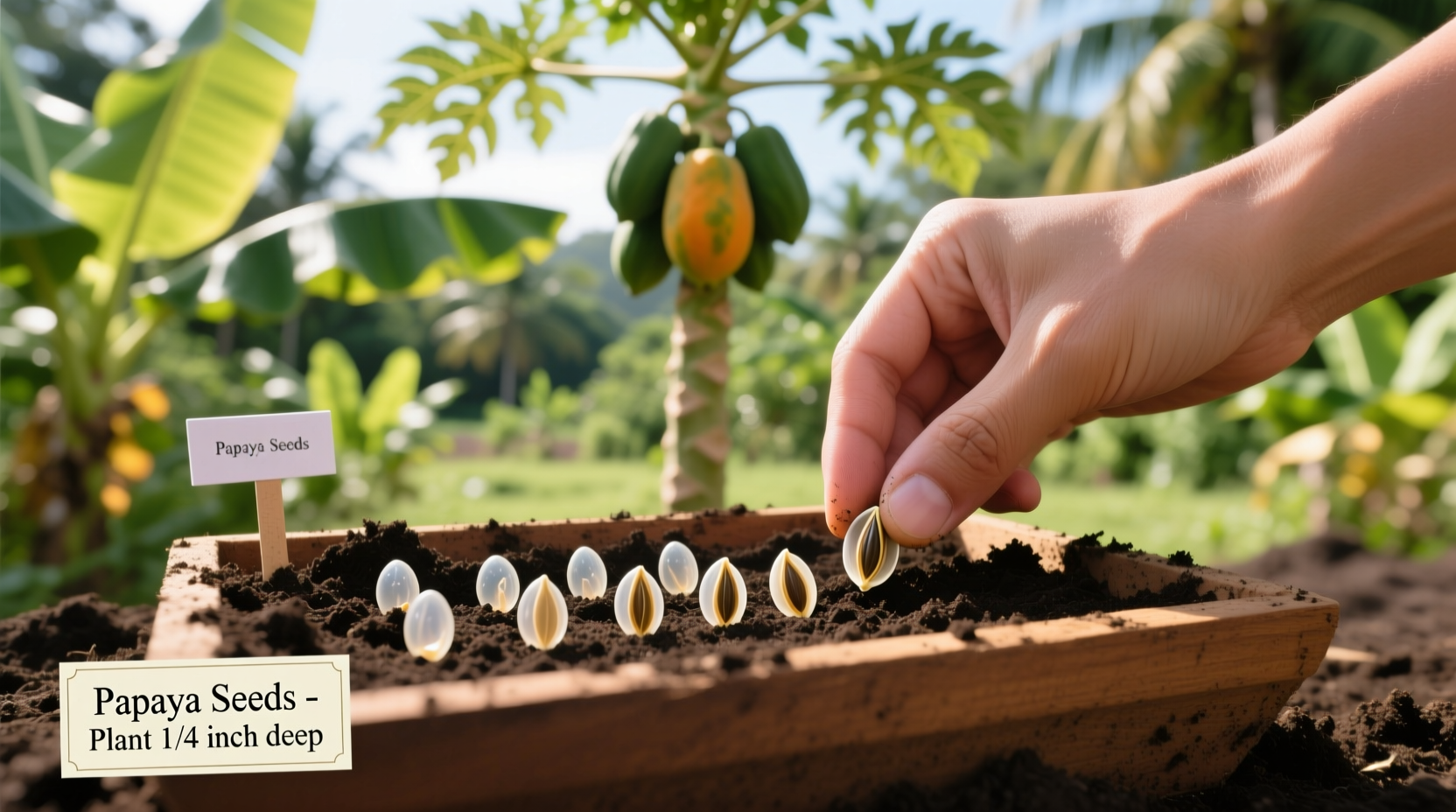Yes, you can successfully grow a papaya tree from seeds in 7 key steps: 1) Extract fresh seeds from ripe papaya, 2) Clean and dry seeds for 24 hours, 3) Plant 1/4 inch deep in well-draining soil (pH 5.5-6.7), 4) Maintain 70-90°F temperature with consistent moisture, 5) Expect germination in 2-5 weeks, 6) Provide 6+ hours of direct sunlight daily, 7) Transplant to final location when 12-18 inches tall. First fruits typically appear 6-12 months after planting with proper care.
Imagine harvesting your own sweet, tropical papayas just steps from your kitchen door. Growing papaya trees from seeds is simpler than most gardeners realize, and with the right approach, you can enjoy homegrown fruit in less than a year. This comprehensive guide reveals exactly how to transform humble papaya seeds into productive fruit-bearing trees, whether you're gardening in USDA zones 9-11 or growing indoors in cooler climates.
Why Growing Papaya from Seeds Beats Buying Seedlings
While nursery-bought papaya seedlings offer convenience, starting from seeds provides significant advantages. You'll develop a stronger root system since the plant isn't stressed from transplanting, access a wider variety of cultivars (including heirloom types unavailable commercially), and enjoy the complete satisfaction of nurturing your tree from its very beginning. Plus, papaya seeds are readily available if you've enjoyed fresh papaya fruit—making this one of the most cost-effective fruit trees to grow.
Seed Selection and Preparation: Your Foundation for Success
The journey to a thriving papaya tree begins with quality seeds. When selecting seeds, choose those from fully ripe, unblemished fruit for maximum viability. Ripe papayas yield darker, more mature seeds with better germination rates. After extracting seeds from the fruit's center:
- Gently rub seeds against a fine mesh strainer to remove the gelatinous coating
- Rinse thoroughly until water runs clear
- Spread seeds on paper towel for 24 hours to dry (don't skip this step—wet seeds may mold)
- Test viability by placing 5 seeds on damp paper towel in sealed bag; check for sprouting after 10 days
According to the University of Florida IFAS Extension, properly prepared papaya seeds maintain 70-80% germination rates when fresh, dropping significantly after 6 months of storage (edis.ifas.ufl.edu/HS135).
Planting Your Papaya Seeds for Optimal Germination
Timing and container selection dramatically impact your success rate. Start seeds indoors year-round in controlled environments, or outdoors after last frost when soil consistently reaches 70°F. For containers:
- Use 4-6 inch pots with drainage holes (peat pots work well for direct transplanting)
- Fill with seed starting mix or equal parts potting soil, perlite, and compost
- Plant 3-5 seeds per container 1/4 inch deep (don't bury too deeply)
- Water gently until moist but not soggy
| Germination Factor | Optimal Range | Problem Range |
|---|---|---|
| Soil Temperature | 75-85°F (24-29°C) | Below 65°F or above 95°F |
| Soil Moisture | Consistently moist | Waterlogged or completely dry |
| Light Exposure | Indirect bright light | Complete darkness |
| Germination Time | 2-5 weeks | More than 6 weeks |

Nurturing Seedlings Through Critical Early Growth
Once sprouts emerge, proper care determines whether your papaya thrives or struggles. When seedlings reach 2-3 inches tall with their first true leaves:
- Thin to strongest plant per container by cutting weaker seedlings at soil level
- Move to location with 6+ hours of direct sunlight daily (use grow lights if needed)
- Maintain consistent moisture—water when top inch of soil feels dry
- Begin fertilizing biweekly with balanced 10-10-10 formula at half strength
Monitor for common seedling issues: damping-off disease (treat with cinnamon powder), nutrient deficiencies (yellowing leaves indicate nitrogen shortage), and leggy growth (sign of insufficient light). The USDA Agricultural Research Service notes that papaya seedlings require careful attention during their first 8 weeks, as this establishes their growth pattern and future fruit production (www.ars.usda.gov/plant-genetics-resources-info/).
Transplanting to Permanent Location: Avoiding Common Mistakes
Transplant when your papaya reaches 12-18 inches tall and outdoor temperatures stay above 60°F. Choose a location with:
- Full sun exposure (minimum 6 hours daily)
- Well-draining soil (amend heavy clay with compost)
- Protection from strong winds
- Minimum 8-10 feet spacing between plants
Dig hole twice as wide as root ball but same depth. Gently loosen roots, place in hole, and backfill with native soil mixed with compost. Water thoroughly and apply 2-3 inch mulch layer (keeping mulch away from stem). Avoid fertilizing for first 4 weeks after transplanting to prevent root burn.
Long-Term Care for Productive Papaya Trees
With proper maintenance, your papaya tree will reward you with fruit for 3-5 years (though they're technically short-lived perennials). Key care practices include:
- Watering: Deep watering 2-3 times weekly during dry periods (more in sandy soil)
- Fertilizing: Balanced citrus fertilizer monthly during growing season
- Pruning: Remove dead leaves and low branches to improve air circulation
- Pest control: Monitor for spider mites and aphids; treat with insecticidal soap
Remember that papaya trees are either male, female, or hermaphroditic—only female and hermaphroditic trees produce fruit. If your tree flowers but doesn't fruit, you may need a second tree for pollination. The University of California Cooperative Extension confirms that hermaphroditic varieties like 'Solo' types produce the most reliable fruit set without requiring multiple trees (ucanr.edu/sites/gardenweb/).
Harvesting and Enjoying Your Homegrown Papayas
Patience pays off when growing papaya from seeds—most trees begin flowering at 4-6 months and produce first fruit at 6-12 months. Watch for these harvest indicators:
- Color change from green to yellow/orange (depending on variety)
- Slight softening when gently pressed
- Fragrant aroma developing
Harvest by cutting fruit from stem with 1-2 inch stem attached. Allow to ripen at room temperature until fully colored. Homegrown papayas typically outperform store-bought in both flavor and nutritional content, with higher vitamin C and digestive enzyme concentrations.
Troubleshooting Common Papaya Growing Challenges
Even with proper care, papaya growers encounter these frequent issues:
- Yellowing leaves: Usually indicates overwatering or nutrient deficiency (test soil)
- No fruit production: Could be male plant, insufficient pollination, or inadequate sunlight
- Black spots on leaves: Sign of fungal infection—improve air circulation and avoid overhead watering
- Stunted growth: Often caused by root-bound container or poor soil nutrition
Remember that papayas are sensitive to cold—temperatures below 55°F cause growth stunting, and below 32°F can kill the plant. In marginal climates, grow in containers you can move indoors during cold snaps.
FAQs About Growing Papaya from Seeds
How long does it take to grow papaya from seed to fruit?
Most papaya trees grown from seeds begin producing fruit 6-12 months after planting, with peak production occurring in the second and third years. The exact timeline depends on climate, variety, and care practices—warmer climates with optimal conditions yield faster results.
Can I grow papaya indoors year-round?
Yes, with sufficient light (minimum 6 hours direct sun or equivalent grow lights) and warm temperatures (70-90°F). Choose dwarf varieties like 'Solo' for container growing, and ensure excellent drainage. Indoor papayas typically grow 5-8 feet tall rather than the 10-15 feet of outdoor trees.
Do I need multiple papaya trees to get fruit?
Not necessarily. Hermaphroditic varieties (like many 'Solo' types) self-pollinate, while female trees require a male or hermaphroditic tree nearby. When growing from seeds, you'll discover your tree's sex when it flowers at 4-6 months. Most home growers find one hermaphroditic tree sufficient for fruit production.
Why are my papaya seeds not germinating?
Common reasons include: old seeds (viability drops after 6 months), improper moisture (too dry or waterlogged), incorrect temperature (below 65°F), or planting too deeply. Fresh seeds from ripe fruit, planted 1/4 inch deep in consistently moist soil at 75-85°F should germinate in 2-5 weeks.











 浙公网安备
33010002000092号
浙公网安备
33010002000092号 浙B2-20120091-4
浙B2-20120091-4